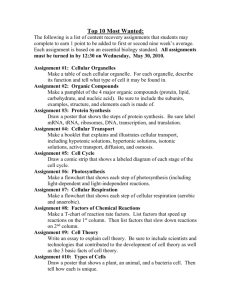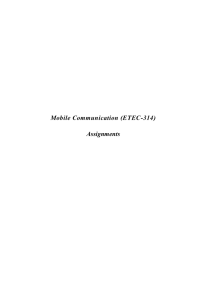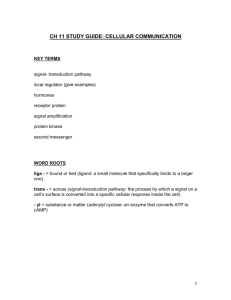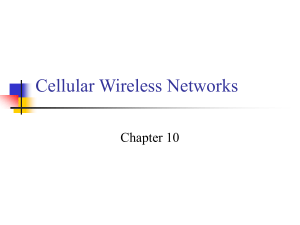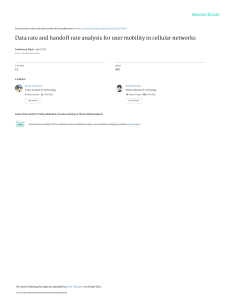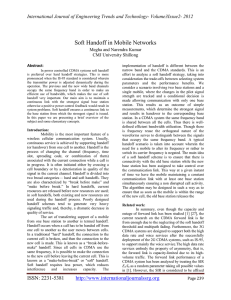15-441 Lecture
advertisement
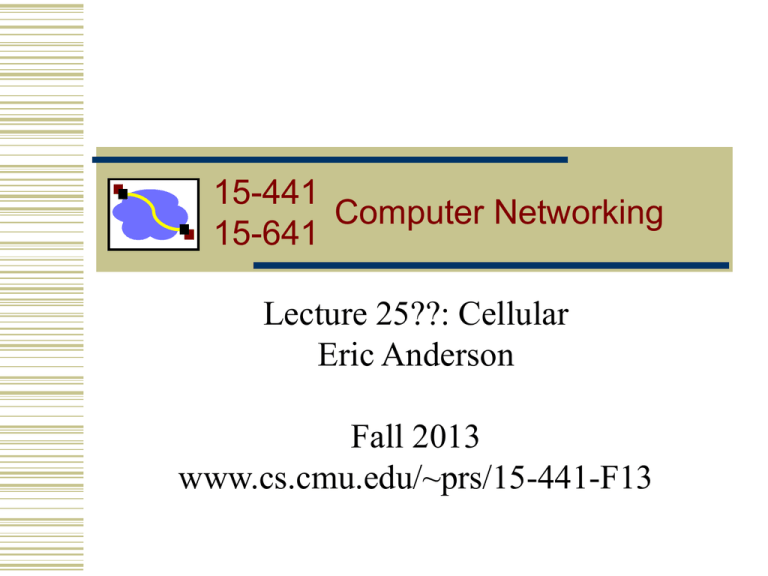
15-441 15-441 Computer Networking 15-641 Lecture 25??: Cellular Eric Anderson Fall 2013 www.cs.cmu.edu/~prs/15-441-F13 Outline • Principles of Cellular Service • Cellular at Layer 1 and Layer 2 From http://ourvaluedcustomers.blogspot.com/2013/10/while-discusing-movies-and-future.html , by Tim Chamberlain 2 Cellular versus WiFi Cellular WiFi Licensed Unlicensed Service model Provisioned “for pay” Unprovisioned “free” – no SLA MAC services Fixed bandwidth SLAs Best effort no SLAs Spectrum Implications WiFi Spectrum Service model MAC services WiFi Implication Unlicensed No control – open, diverse access No guarantees Unprovisioned maximize throughput, “free” fairness Best effort no SLAs ??? Implications Cellular Spectrum Service model MAC services Cellular Implication Licensed Provider has control over interference Provisioned “for pay” Can and must charge + make commitments Fixed bandwidth TDMA, FDMA, CDMA; access control SLAs Overview • • • • • • • • • Cellular design Frequency Reuse Capacity and Interference Elements of a cellular network How does a mobile phone take place? Paging Handoff Frequency Allocation Traffic Engineering The Advent of Cellular Networks • Mobile radio telephone system was based on: • High power transmitter/receivers • Could support about 25 channels • in a radius of 80 Km • To increase network capacity: • Multiple low-power transmitters (100W or less) • Small transmission radius -> area split in cells • Each cell with its own frequencies and base station • Adjacent cells use different frequencies • The same frequency can be reused at sufficient distance Cellular Network Design Options • Simplest layout • Adjacent antennas not equidistant – how do you handle users at the edge d of the cell? • Ideal layout • But we know signals travel whatever way they fell like d √2d d d The Hexagonal Pattern • A hexagon pattern can provide equidistant access to neighboring cell towers • d = √3R • In practice, variations from ideal due to topological reasons • Signal propagation • Tower placement d R Call progression (a) Monitor for strongest signal (b) Request for connection Call progression (c) Paging (d) Call accepted Call progression (e) Ongoing call (f) Handoff Handoff between 2 cells Base station A Base station B Handoff Options • Switch when a different cell is better … or the current one is too bad. • Defined how? Who measures? How often? • What thresholds? • Set up new connection before tearing down the old one? • What kind of resources are involved? • How do you deliver data while >1 connections open? 14 Handoff • Could be network or client initiated • Target performance metrics: • Cell blocking probability • Call dropping probability • Call completion probability • Probability of unsuccessful handoff • Handoff blocking probability • Handoff probability • Rate of handoff • Interruption duration • Handoff delay Frequency reuse • Each cell features one base transceiver • Through power control cover the cell area while limiting the power leaking to other co-frequency cells • Frequency reuse not possible for adjacent towers! • The number of frequency bands assigned to a cell dependent on its traffic Minimum separation? How to Increase Capacity? • • • • Adding new channels Frequency borrowing Sectoring antennas Microcells • Antennas on top of buildings, even lamp posts • Form micro cells with reduced power • Good for city streets, roads and inside buildings Cell splitting • Cell size ~ 6.5-13Km, Minimum ~ 1.5Km • Requires careful power control and possibly more frequent handoffs for mobile stations • A radius reduction by a factor of 𝐹 reduces the coverage area and increases the required number of base stations by a factor of 𝐹 2 Cell splitting Radius of small cell half that of the original Cell sectoring • Cell divided into wedge shaped sectors • 3-6 sectors per cell, each with own channel set • Subset of cell’s channel, use of directional antennas Cell Sectoring - Interference 1/3 Outline • Principles of Cellular Service • Cellular at Layer 1 and Layer 2 From http://ourvaluedcustomers.blogspot.com/2013/10/while-discusing-movies-and-future.html , by Tim Chamberlain 23 GSM Multiple Access • • • • Combination of FDD, FDMA and TDMA 890-915 MHz for uplink 935-960 MHz for downlink Each of those 25 MHz bands is sub divided into 124 single carrier channel of 200 KHz • In each uplink/downlink band there is a 200 KHz guard band • Each 200 KHz channel carries 8 TDMA channels FDMA/TDMA LTE • Some slides from • Tsung-Yin Lee • Roger Piqueras Jover 26 LTE spectrum (bandwidth and duplex) flexibility 27 Resource Grid • One frame is 10ms 10 subframes • One subframe is 1ms 2 slots • One slot is 0.5ms N resource blocks [ 6 < N < 110] • One resource block is 0.5ms and contains 12 subcarriers from each OFDM symbol 28 LTE Downlink Channels Paging Control Channel Paging Channel Physical Downlink Shared Channel 29 LTE Uplink Channels Random Access Channel CQI report Physical Uplink Shared Channel Physical Radio Access Channel 30 Rates and spectral efficiency Growth Explanation • • • • • • No impact on spectral efficiency or network capacity Allocating more time (TDMA duty cycle) Increase Allocating more bandwidth peak Improving frequency reuse data Reducing channel coding protection rates Using higher order modulation Taking advantage of spatial diversity (MIMO) Increase spectral efficiency and can increase network capacity Average vs. peak rate AMPS, GSM designed to operate at their maximum rate at the edge of the cell






